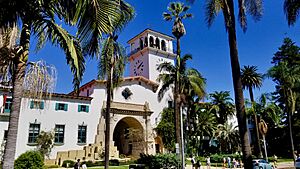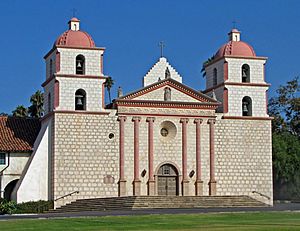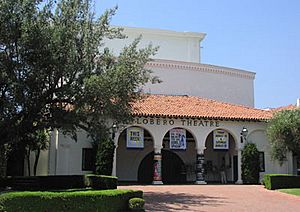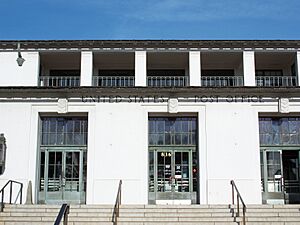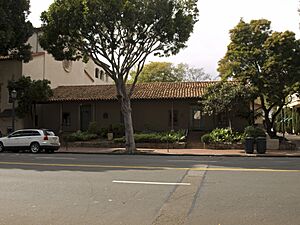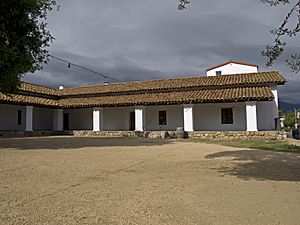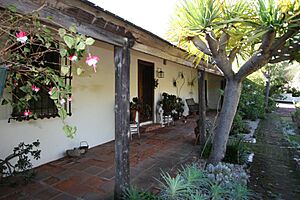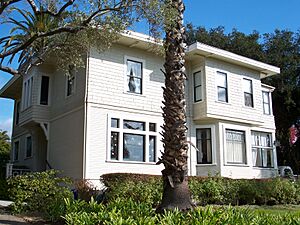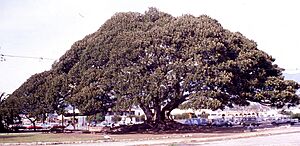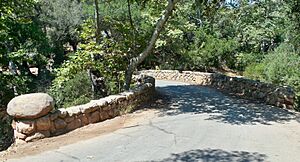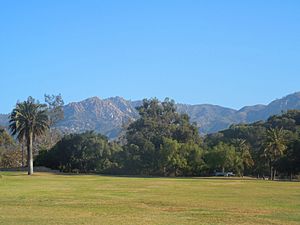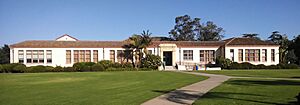City of Santa Barbara Historic Landmarks facts for kids
The City of Santa Barbara Historic Landmarks are special buildings and places in Santa Barbara, California that the city has officially recognized as important because of their history. The city also keeps lists of other cool old buildings and areas that might become landmarks one day.
You can see where these landmarks are on a map! Just click "OpenStreetMap" in the box to the right.
Contents
Discovering Santa Barbara's Historic Landmarks
Santa Barbara is full of amazing old buildings and sites that tell stories about the past. These places are called Historic Landmarks because they are super important to the city's history and culture. Some of these landmarks are so special that they are also listed on the National Register of Historic Places, which means they are important to the whole country!
Iconic Buildings and Structures
Santa Barbara has many famous buildings that are historic landmarks. These places often have unique architecture and interesting stories.
Santa Barbara County Courthouse
The Santa Barbara Courthouse is one of the most beautiful buildings in the city. It was built between 1927 and 1929. This amazing building is known for its Spanish Colonial Revival style, with cool towers, arches, and colorful tiles. It's not just a city landmark; it's also a National Historic Landmark! You can even go inside and see the amazing murals and climb the clock tower for incredible views of Santa Barbara.
Mission Santa Barbara
The Mission Santa Barbara is one of California's most famous missions. It was founded way back in 1786 by Padre Fermín Lasuén. The mission buildings you see today were mostly built between 1815 and 1820. It's a stunning example of Spanish Colonial architecture and has been a National Historic Landmark since 1960. It's often called the "Queen of the Missions" because of its beauty.
Lobero Theatre
The Lobero Theatre is a very special place for performances. It was built in 1924 and designed by famous architects George Washington Smith and Lutah Maria Riggs. It's known as the oldest continuously operating theater in California! Imagine all the shows and performances that have happened there over the years.
Arlington Theatre
Another grand place for entertainment is the Arlington Theatre, built in 1930–31. It was designed by Edwards and Plunkett and has a unique Spanish Colonial Revival style that makes you feel like you're stepping into an old Spanish village. It's still a popular spot for movies and live shows today.
Santa Barbara Post Office
The Santa Barbara Post Office was built in 1936-37. It has a cool design that mixes Mission Revival and Art Deco styles. It was designed by Reginald Davis Johnson, an architect from Pasadena. This building has been on the National Register of Historic Places since 1985.
Historic Homes and Adobes
Many of Santa Barbara's landmarks are old homes, some of them made of adobe, a traditional building material.
Orena Adobes
The Orena Adobes are a group of historic adobe homes built in 1849 and 1858. These buildings give us a peek into what homes looked like in Santa Barbara a long time ago.
Hill–Carrillo Adobe
The Hill–Carrillo Adobe was built between 1825 and 1826. It's another great example of early Santa Barbara architecture. This adobe is also a California Historical Landmark.
Casa de la Guerra
The Casa de la Guerra was built between 1819 and 1827. It was the home of José de la Guerra, a very important person in early Santa Barbara. This large adobe house is a fantastic example of Spanish Colonial architecture and helps us understand life in the 1800s.
Gonzales-Ramirez Adobe
The Gonzales-Ramirez Adobe was built in 1825. The Gonzales family lived here for nearly 100 years! It's also a National Historic Landmark and now houses a rare book store.
Hezekiah G. and Pearl Chase Home
This home, built in 1904, belonged to Hezekiah G. and Pearl Chase. They were important figures in Santa Barbara's history, especially in preserving its unique architectural style.
Unique Natural and Public Landmarks
Not all landmarks are buildings; some are natural features or public spaces.
Moreton Bay Fig Tree and Park
The Moreton Bay Fig Tree is a giant, amazing tree that was planted around 1874. It's one of the largest fig trees in the United States and a truly impressive sight! It's a living landmark.
Rattlesnake Canyon Bridge
The Rattlesnake Canyon Bridge was built in 1919. It's a unique bridge made of sandstone by a mason named Peter Poole. It's a cool example of early engineering and craftsmanship. This bridge was added to the National Register of Historic Places in 2017.
Mission Historical Park
Mission Historical Park is a beautiful public space that was established in 1920. It's a great place to relax and enjoy nature, and it's also part of the historic setting around Mission Santa Barbara.
Schools as Landmarks
Some of Santa Barbara's schools are also recognized as historic landmarks, showing their importance to the community's past.
Santa Barbara Junior High School
Santa Barbara Junior High School was built in 1932. It was designed by the San Francisco-based architecture firm W. H. Weeks. It's a great example of school architecture from that time.
Santa Barbara High School
The main building of Santa Barbara High School was built in 1924, with the Figueroa Street Ticket Booth added in 1934. It was also designed by W. H. Weeks. It's a beautiful and historic campus that has educated many generations of students.
See also


